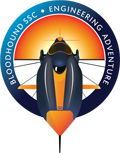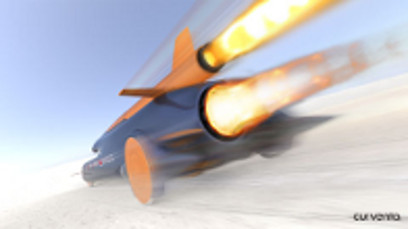





Triple engined landspeed car
A news piece written for New Scientist magazine and picked up online. I had expected the key aspect of the story would be the successful engine tests; but NS were so struck by the extraordinary propulsion system proposed for Bloodhound that the emphasis was placed in that direction.

When Richard Noble's new land speed challenger, Bloodhound SSC, streaks across a desert sometime in 2011 it'll be powered by no less than three different types of engine. A rocket will boost the car up to Mach1,
while a Eurofighter jet engine will provide a more controllable thrust to coax it up to 1000mph. Finally a 596 kW V12 piston engine is on board to pump the propellants and provide power to the jet and rocket.
The day of reckoning has come closer this month with the announcement from the team that the first tests of the rocket system have been carried out. A 1/3 scale development engine was fired 10 times at a test site in the Mojave Desert,
running up to a maximum burn time of 12 seconds. The engine, being developed by Daniel Jubb's Falcon project, is a hybrid burning a solid fuel, polyethylene, with a liquid oxidiser. The polyethylene, just the same stuff as in plastic bags,
is in the form of a cylinder with a hole running down the middle; hydrogen peroxide is then squirted into the hole which burns the plastic from the inside out.
"Scaling up hybrids can be difficult because the fluid flow inside the engine, or its 'ballistics' can change quite significantly as the size of the port in the fuel goes up, but this first engine looks to be functioning
very efficiently from the shape of the flame and the distinct Mach diamonds in the exhaust. Surrey Satellites' Adam Baker, an engineer with experience of a number of complex aerospace projects including hybrid
rocket development and hydrogen peroxide propellants. "The big challenge for Bloodhound will be bringing all these separate systems together and making them safely function as a whole, rocket propulsion is still a
complex and risky engineering endeavour but these tests appear to be a very promising start. Best wishes to Daniel and the entire Bloodhound team."
Bloodhound draws on many of team members from the current record holder Thrust SSC, including driver Andy Green, and is named for aerodynamicist Ron Ayers'
first 1000mph project, the Bloodhound missile.
